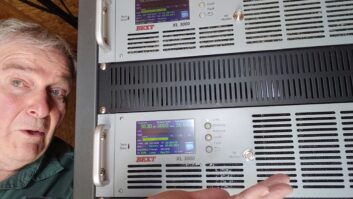(click thumbnail)Fig. 1
(click thumbnail)Fig. 2
(click thumbnail)Fig. 3
(click thumbnail)Fig. 4
(click thumbnail)Fig. 5
(click thumbnail)Fig. 6
(click thumbnail)Fig. 7
(click thumbnail)Fig. 8
(click thumbnail)Fig. 9
(click thumbnail)Fig. 10 We’ve all visited transmitter sites where the grass, vegetation, weeds, vines and trees seem to spring up overnight.
In most cases the sites have been neglected. Sometimes this is unintentional; the engineers simply are overworked. But visiting every transmitter site is time spent well.
In some cases, sites are acquired and the engineer has no control over what is inherited. This is where a good due-diligence inspection can save an owner thousands.
New World Radio Director of Engineering and Operations Brian Edwards inherited such a site. Here is a pictorial essay of any engineer’s worst nightmare.
Through the years, the AM site basically was forgotten. After all, the station was on the air, right? Add to that zero budget to handle transmitter site basics like grass mowing, and seemingly “overnight” a jungle appeared, as seen in Fig. 1. Grass turned into bushes, bushes grew into trees. When the keys to the site were handed to Brian, a tree was growing through one guy anchor point.
In addition to the brush and tree issue, dirt had buried several of the guy wire turnbuckles. It wasn’t a pretty picture. Brian’s first course of action was to get a better picture of the situation by removing the brush.
A job this intense required some heavy machinery, as you can see in Fig. 2. Brian had the experience to operate a backhoe. If you’ve never operated such machinery, hire a professional to do the job. Clipping a guy wire and toppling a tower is pretty expensive on-the-job training.
Fig. 3 shows that once the brush was cleared away, a closer inspection of the anchor point could be made. At this point, Brian realized the turnbuckles were not just covered with weeds; they were buried in dirt, as seen in Fig. 4.
Fig. 5 shows the dirt around the anchor point being removed with care by the backhoe operator. In Fig. 6, the excavated guy is visible. To prevent further burial, Brian is building a retaining wall using landscape ties. Gravel will cover the area around the anchor after the turnbuckles are replaced.
Being buried for who — knows — how-long caused severe rust on the turnbuckles. To guard against future growth, a piece of landscape fabric will be placed under the gravel.
The fun wasn’t over yet. At another guy anchor, a tree was growing. Fig. 7 shows the stump, which had to be cut away carefully.
This anchor point also was buried. Note the tree stump to the left of the anchor point, as Brian unearths the guys in Fig. 8. Fig. 9 is a closeup of the stump and the buried turnbuckles.
Brian likens tree stumps to icebergs – there’s a lot going on underneath, as you can see in Fig. 10 as the stump is hauled off. After the stump is removed, the area around this anchor point was graded as shown in Fig. 11. Again, a retaining wall with landscape timbers, landscape fabric around the anchor and a layer of clean gravel will prevent future growth.
It goes without saying that the commercial cost to have this work done would approach thousands of dollars. And Brian’s work could have been complicated further had these anchor points been within the station’s ground system. Roots and copper radials don’t mix.
After the work is completed, retain the services of a qualified tower company to inspect and replace damaged components. This will help to ensure that your towers will be standing. Remember, today’s vines are tomorrow’s trees. Visit your site regularly, and practice a regular routine of vegetation control. Brian Edwards can be reached at [email protected]
Working on a project of your own? Bring along a digital camera and submit the pix to Workbench.
Submissions for this column are encouraged, and qualify for SBE recertification credit. Fax your submission to (703) 323-8044, or send e-mail to [email protected]






















